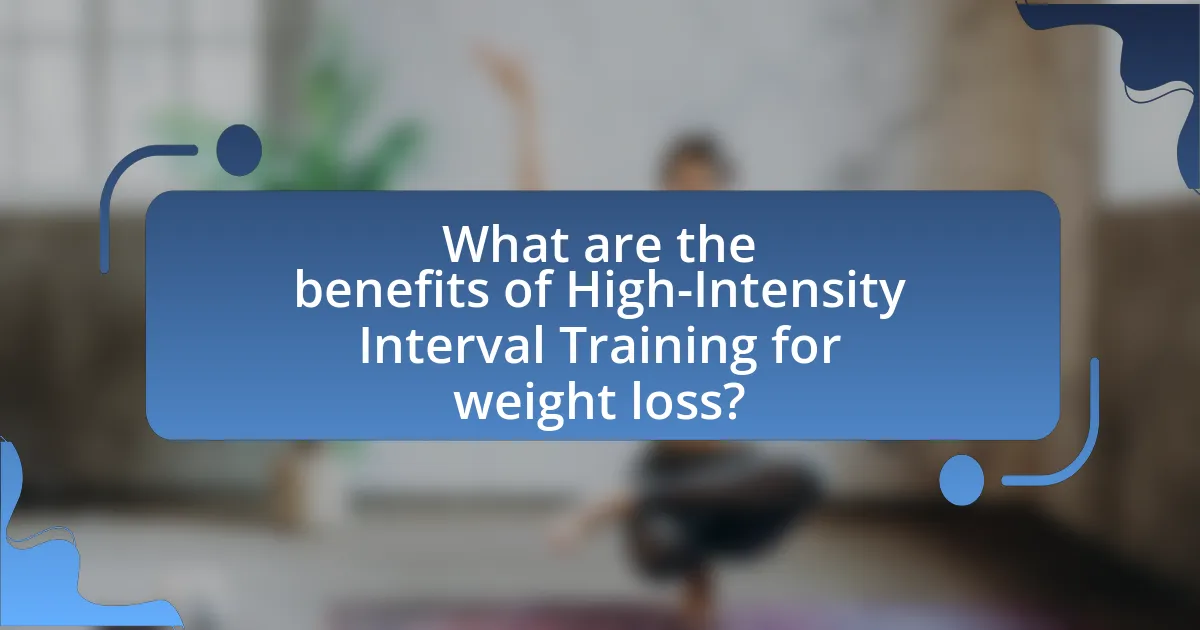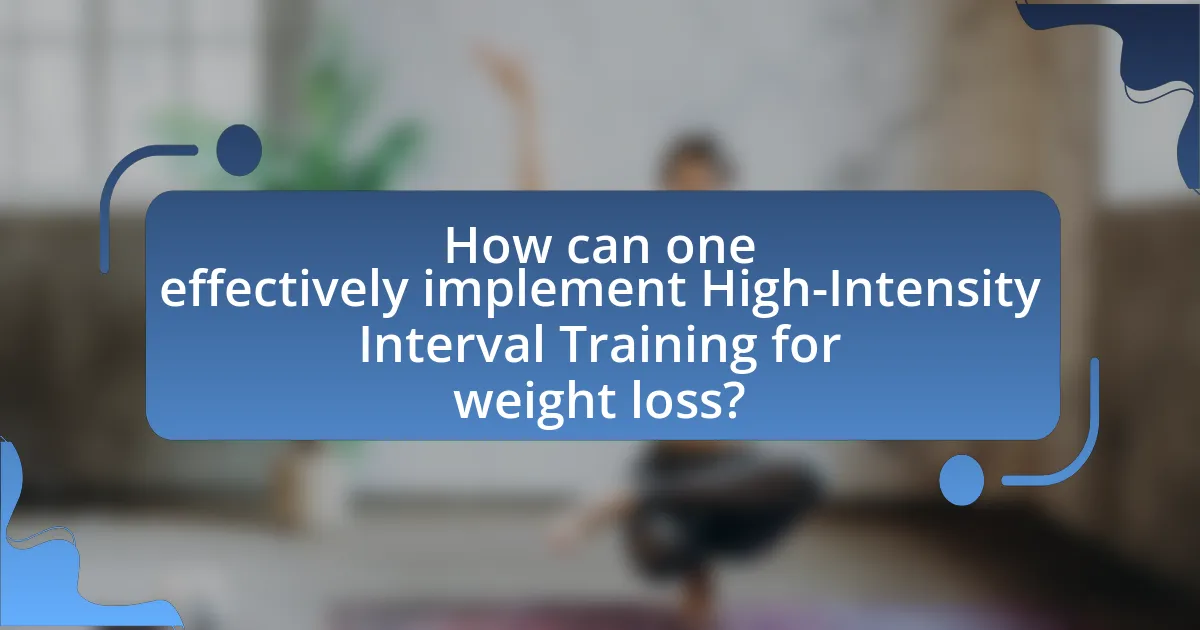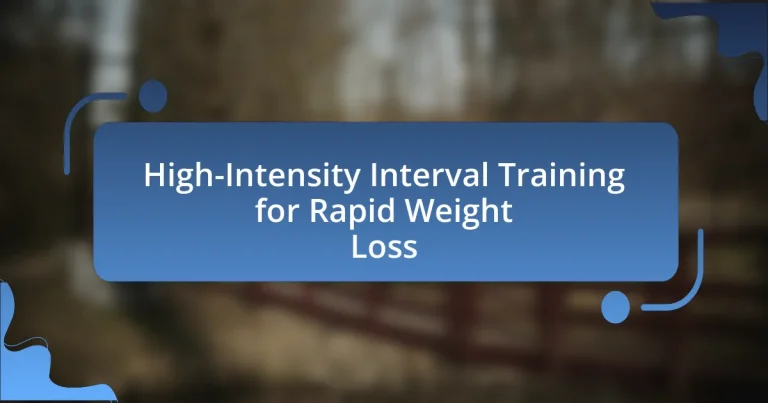High-Intensity Interval Training (HIIT) is an effective exercise method for rapid weight loss, characterized by alternating short bursts of intense activity with periods of rest or lower-intensity exercise. This training approach has been shown to enhance metabolic rate, promote fat loss, and improve cardiovascular fitness more efficiently than traditional steady-state cardio. Key principles of HIIT include measuring intensity through heart rate and perceived exertion, understanding the physiological effects such as increased insulin sensitivity, and recognizing the importance of the afterburn effect in calorie burning post-exercise. The article also discusses recommended durations and frequencies for HIIT sessions, suitable exercises, and modifications for different fitness levels, while highlighting the significance of nutrition and recovery strategies to optimize weight loss outcomes.

What is High-Intensity Interval Training for Rapid Weight Loss?
High-Intensity Interval Training (HIIT) for rapid weight loss is a form of exercise that alternates between short bursts of intense activity and periods of rest or lower-intensity exercise. This training method has been shown to increase metabolic rate and promote fat loss more effectively than traditional steady-state cardio. Research indicates that HIIT can lead to significant reductions in body fat and improvements in cardiovascular fitness, with studies demonstrating that participants can burn more calories in a shorter amount of time compared to moderate-intensity workouts. For instance, a study published in the Journal of Obesity found that individuals engaging in HIIT lost 1.5 times more body fat than those performing moderate-intensity exercise over the same duration.
How does High-Intensity Interval Training differ from traditional exercise?
High-Intensity Interval Training (HIIT) differs from traditional exercise primarily in its structure and intensity. HIIT involves short bursts of intense activity followed by rest or low-intensity periods, typically lasting from a few seconds to a few minutes, while traditional exercise often consists of steady-state activities performed at a moderate intensity for longer durations. Research indicates that HIIT can lead to greater improvements in cardiovascular fitness and fat loss in a shorter amount of time compared to traditional exercise, which generally requires longer sessions to achieve similar results. For instance, a study published in the Journal of Obesity found that participants engaging in HIIT lost more body fat over a 12-week period compared to those performing moderate-intensity continuous training.
What are the key principles of High-Intensity Interval Training?
The key principles of High-Intensity Interval Training (HIIT) include alternating short bursts of intense exercise with periods of rest or lower-intensity exercise. This method maximizes calorie burn and improves cardiovascular fitness in a shorter time frame compared to traditional steady-state cardio. Research indicates that HIIT can increase metabolic rate for hours after exercise, leading to greater fat loss. A study published in the Journal of Obesity found that participants engaging in HIIT lost more body fat than those performing moderate-intensity continuous training over the same period.
How is the intensity measured in High-Intensity Interval Training?
Intensity in High-Intensity Interval Training (HIIT) is primarily measured using heart rate, perceived exertion, and power output. Heart rate monitoring involves tracking the percentage of maximum heart rate achieved during intervals, with high-intensity efforts typically reaching 80-95% of maximum heart rate. The Rate of Perceived Exertion (RPE) scale, which ranges from 6 to 20, allows individuals to subjectively assess their exertion level, with higher numbers indicating greater intensity. Additionally, power output can be measured using devices like power meters or ergometers, quantifying the work done during high-intensity efforts. These methods provide a comprehensive understanding of intensity, ensuring that workouts are appropriately challenging for effective weight loss.
What are the physiological effects of High-Intensity Interval Training?
High-Intensity Interval Training (HIIT) leads to several physiological effects, including improved cardiovascular fitness, increased metabolic rate, and enhanced insulin sensitivity. Research indicates that HIIT can elevate heart rate and oxygen consumption more significantly than moderate-intensity continuous exercise, resulting in greater cardiovascular adaptations. A study published in the Journal of Obesity by Gibala et al. (2014) demonstrated that participants engaging in HIIT experienced a 25-30% increase in aerobic capacity over a short period compared to traditional endurance training. Additionally, HIIT has been shown to boost post-exercise oxygen consumption, leading to increased calorie burn even after the workout, which contributes to weight loss. Furthermore, HIIT enhances insulin sensitivity, which is crucial for glucose metabolism and can reduce the risk of type 2 diabetes, as evidenced by a study in the Journal of Applied Physiology by Little et al. (2011).
How does High-Intensity Interval Training impact metabolism?
High-Intensity Interval Training (HIIT) significantly boosts metabolism by increasing the rate of calorie burn during and after exercise. This effect, known as excess post-exercise oxygen consumption (EPOC), can elevate metabolic rate for hours post-workout, leading to greater overall energy expenditure. Research indicates that HIIT can increase metabolic rate by 6-15% for up to 24 hours after the workout, compared to steady-state cardio, which typically has a lower post-exercise metabolic boost. Studies, such as those published in the Journal of Obesity by Gibala et al., demonstrate that HIIT not only enhances aerobic capacity but also improves insulin sensitivity, further contributing to metabolic health.
What role does the afterburn effect play in weight loss?
The afterburn effect, scientifically known as excess post-exercise oxygen consumption (EPOC), plays a significant role in weight loss by increasing the number of calories burned after high-intensity workouts. This phenomenon occurs as the body requires additional oxygen to restore itself to a resting state, leading to an elevated metabolic rate for hours or even days post-exercise. Research indicates that high-intensity interval training (HIIT) can elevate EPOC significantly more than steady-state cardio, with studies showing that EPOC can increase calorie expenditure by 6-15% after intense workouts. This increased calorie burn contributes to a greater overall caloric deficit, which is essential for weight loss.
What are the recommended durations and frequencies for High-Intensity Interval Training?
The recommended duration for High-Intensity Interval Training (HIIT) sessions is typically between 20 to 30 minutes, while the frequency is advised to be 2 to 3 times per week. Research indicates that HIIT can be effective for weight loss and cardiovascular fitness within this time frame, as it allows for maximum effort during short bursts followed by recovery periods. A study published in the Journal of Obesity found that participants who engaged in HIIT for 20 minutes, three times a week, experienced significant fat loss compared to those who performed steady-state cardio for longer durations.
How long should each interval last for optimal results?
Each interval in High-Intensity Interval Training (HIIT) should last between 20 to 60 seconds for optimal results. Research indicates that shorter intervals of 20 to 30 seconds can maximize anaerobic capacity, while longer intervals of 40 to 60 seconds can enhance aerobic endurance. A study published in the Journal of Obesity by Gibala et al. (2012) found that participants who engaged in HIIT with intervals of 30 seconds showed significant improvements in body composition and cardiovascular fitness compared to traditional steady-state exercise. Thus, the duration of each interval plays a crucial role in achieving effective weight loss and fitness gains.
How many sessions per week are ideal for weight loss?
For effective weight loss, it is ideal to engage in high-intensity interval training (HIIT) sessions three to five times per week. Research indicates that this frequency can optimize fat loss while maintaining muscle mass. A study published in the Journal of Obesity by Trapp et al. (2008) found that participants who performed HIIT three times a week experienced significant reductions in body fat compared to those who exercised less frequently. Therefore, three to five sessions per week is supported by evidence as an effective approach for weight loss through HIIT.

What are the benefits of High-Intensity Interval Training for weight loss?
High-Intensity Interval Training (HIIT) significantly enhances weight loss by increasing calorie burn during and after workouts. This training method involves short bursts of intense exercise followed by rest or low-intensity periods, which elevates the heart rate and boosts metabolism. Research indicates that HIIT can lead to a greater reduction in body fat compared to traditional steady-state cardio. A study published in the Journal of Obesity found that participants engaging in HIIT lost 1.5 times more body fat than those performing moderate-intensity exercise over the same period. Additionally, HIIT promotes muscle retention while losing fat, which is crucial for maintaining a healthy metabolism.
How does High-Intensity Interval Training enhance fat burning?
High-Intensity Interval Training (HIIT) enhances fat burning by significantly increasing the metabolic rate during and after exercise. This occurs because HIIT involves short bursts of intense activity followed by rest or low-intensity periods, which elevates heart rate and energy expenditure. Research indicates that HIIT can lead to a greater reduction in body fat compared to steady-state cardio, with a study published in the Journal of Obesity showing that participants who engaged in HIIT lost 1.5 times more body fat than those who performed moderate-intensity exercise over the same period. This increased fat oxidation is attributed to the afterburn effect, or excess post-exercise oxygen consumption (EPOC), where the body continues to burn calories at an elevated rate post-workout.
What evidence supports the effectiveness of High-Intensity Interval Training for weight loss?
High-Intensity Interval Training (HIIT) is supported by substantial evidence as an effective method for weight loss. Research indicates that HIIT can lead to greater fat loss compared to traditional steady-state cardio. A meta-analysis published in the British Journal of Sports Medicine in 2018, which reviewed 39 studies, found that HIIT resulted in a significant reduction in body fat percentage and waist circumference. Additionally, a study by Keating et al. (2017) in the Journal of Obesity demonstrated that participants engaging in HIIT lost more weight over a 12-week period compared to those performing moderate-intensity continuous training. These findings collectively underscore HIIT’s efficacy in promoting weight loss through enhanced calorie burn and metabolic rate.
How does High-Intensity Interval Training compare to steady-state cardio for weight loss?
High-Intensity Interval Training (HIIT) is generally more effective for weight loss compared to steady-state cardio. Research indicates that HIIT can lead to greater fat loss in a shorter amount of time due to its ability to elevate metabolic rate post-exercise, a phenomenon known as excess post-exercise oxygen consumption (EPOC). A study published in the Journal of Obesity by Trapp et al. (2008) found that participants engaging in HIIT lost more body fat over a 15-week period compared to those performing steady-state cardio, despite both groups having similar caloric expenditures. This suggests that the intensity and structure of HIIT can provide superior weight loss benefits.
What additional health benefits does High-Intensity Interval Training provide?
High-Intensity Interval Training (HIIT) provides several additional health benefits beyond weight loss, including improved cardiovascular health, enhanced metabolic rate, and increased insulin sensitivity. Research indicates that HIIT can lead to significant reductions in blood pressure and resting heart rate, contributing to overall heart health. A study published in the Journal of Obesity found that participants engaging in HIIT experienced a 28.5% increase in insulin sensitivity compared to those who performed moderate-intensity continuous training. Furthermore, HIIT has been shown to elevate post-exercise oxygen consumption, which can boost calorie burn for hours after the workout, enhancing metabolic efficiency.
How can High-Intensity Interval Training improve cardiovascular health?
High-Intensity Interval Training (HIIT) can improve cardiovascular health by enhancing heart efficiency and increasing aerobic capacity. Studies show that HIIT leads to significant improvements in cardiovascular fitness, as evidenced by a meta-analysis published in the British Journal of Sports Medicine, which found that HIIT can increase VO2 max, a key indicator of cardiovascular health, by 4-16% in various populations. Additionally, HIIT has been shown to reduce resting heart rate and improve blood pressure, contributing to overall heart health. These physiological adaptations occur due to the intense bursts of activity followed by recovery periods, which stimulate cardiovascular adaptations more effectively than moderate-intensity continuous training.
What impact does High-Intensity Interval Training have on muscle retention during weight loss?
High-Intensity Interval Training (HIIT) positively impacts muscle retention during weight loss by promoting the preservation of lean muscle mass while facilitating fat loss. Research indicates that HIIT can stimulate muscle protein synthesis and enhance metabolic rate, which helps maintain muscle during caloric deficits. A study published in the Journal of Obesity by Boutcher (2011) found that individuals engaging in HIIT experienced greater retention of muscle mass compared to those performing steady-state cardio during weight loss. This suggests that incorporating HIIT into a weight loss regimen can effectively support muscle retention.
What are the potential risks or drawbacks of High-Intensity Interval Training?
High-Intensity Interval Training (HIIT) can lead to several potential risks or drawbacks, including increased risk of injury, cardiovascular strain, and inadequate recovery. The intense nature of HIIT workouts can result in musculoskeletal injuries, particularly for individuals who are not accustomed to high-impact exercises. A study published in the Journal of Sports Medicine indicated that improper form and overexertion during HIIT can lead to injuries such as sprains and strains. Additionally, the high demands placed on the cardiovascular system may pose risks for individuals with pre-existing heart conditions, as noted in research from the American Heart Association. Lastly, inadequate recovery time between sessions can lead to overtraining syndrome, characterized by fatigue and decreased performance, as highlighted in findings from the Journal of Strength and Conditioning Research.
Who should avoid High-Intensity Interval Training?
Individuals with certain health conditions should avoid High-Intensity Interval Training (HIIT). Specifically, those with cardiovascular issues, respiratory problems, joint injuries, or chronic illnesses may experience adverse effects from the intense nature of HIIT. Research indicates that high-intensity workouts can elevate heart rates significantly, which may pose risks for individuals with heart disease or hypertension. Additionally, people recovering from surgery or those who are new to exercise should consult healthcare professionals before engaging in HIIT to prevent injury or complications.
What precautions should be taken to prevent injury during High-Intensity Interval Training?
To prevent injury during High-Intensity Interval Training (HIIT), individuals should prioritize proper warm-up, use correct form, and listen to their bodies. A thorough warm-up increases blood flow to muscles and prepares the body for intense activity, reducing the risk of strains. Maintaining correct form during exercises minimizes the likelihood of injuries, as improper technique can lead to undue stress on joints and muscles. Additionally, individuals should pay attention to their body’s signals; if pain or discomfort arises, it is crucial to modify or stop the exercise to prevent further injury. Research indicates that following these precautions can significantly lower the risk of injury in high-intensity workouts, as highlighted in studies on exercise safety and injury prevention.

How can one effectively implement High-Intensity Interval Training for weight loss?
To effectively implement High-Intensity Interval Training (HIIT) for weight loss, one should incorporate short bursts of intense exercise followed by brief recovery periods. Research indicates that HIIT can increase metabolic rate and promote fat loss more efficiently than traditional steady-state cardio. For instance, a study published in the Journal of Obesity found that participants who engaged in HIIT lost significantly more body fat compared to those who performed moderate-intensity continuous training over the same duration. A practical approach includes selecting exercises such as sprinting, cycling, or bodyweight movements, performing them at maximum effort for 20-30 seconds, followed by 10-30 seconds of rest, and repeating this cycle for 15-30 minutes. This method not only maximizes calorie burn during and after workouts but also enhances cardiovascular fitness, making it a highly effective strategy for weight loss.
What types of exercises are suitable for High-Intensity Interval Training?
High-Intensity Interval Training (HIIT) is suitable for various exercises, including sprinting, cycling, bodyweight exercises, and resistance training. Sprinting, for instance, can be performed in short bursts of maximum effort followed by rest, effectively elevating heart rate and burning calories. Cycling can be done on stationary bikes or outdoors, alternating between high-intensity pedaling and lower-intensity recovery periods. Bodyweight exercises such as burpees, jump squats, and push-ups can also be incorporated into HIIT routines, allowing for a full-body workout that enhances strength and endurance. Resistance training, utilizing weights or resistance bands, can be structured in intervals to maximize muscle engagement and metabolic rate. These exercise types are validated by numerous studies showing their effectiveness in improving cardiovascular fitness and promoting rapid weight loss through increased calorie expenditure during and after workouts.
How can bodyweight exercises be incorporated into High-Intensity Interval Training?
Bodyweight exercises can be incorporated into High-Intensity Interval Training (HIIT) by structuring workouts that alternate between high-intensity bodyweight movements and short rest periods. For example, a HIIT session may include exercises such as push-ups, squats, and burpees performed at maximum effort for 30 seconds, followed by a 15-second rest, repeated for several rounds. This method effectively elevates heart rate and promotes calorie burning, which is essential for rapid weight loss. Research indicates that HIIT can increase metabolic rate and improve cardiovascular fitness, making bodyweight exercises an efficient choice within this training framework.
What equipment can enhance High-Intensity Interval Training sessions?
High-Intensity Interval Training (HIIT) sessions can be enhanced with equipment such as kettlebells, battle ropes, resistance bands, and plyometric boxes. Kettlebells provide dynamic strength training and cardiovascular benefits, while battle ropes engage multiple muscle groups and improve endurance. Resistance bands offer versatility for strength training and can be easily adjusted for different resistance levels. Plyometric boxes facilitate explosive movements, enhancing power and agility. Studies indicate that incorporating such equipment can lead to increased calorie burn and improved overall fitness during HIIT workouts.
What are some sample High-Intensity Interval Training workouts for beginners?
Sample High-Intensity Interval Training (HIIT) workouts for beginners include a variety of exercises that can be performed in short bursts followed by rest periods. One effective beginner workout consists of 20 seconds of jumping jacks followed by 40 seconds of rest, repeated for 10 rounds. Another option is 30 seconds of bodyweight squats followed by 30 seconds of rest, repeated for 8 rounds. A third example is 20 seconds of high knees followed by 40 seconds of rest, repeated for 6 rounds. These workouts are designed to elevate heart rate and improve cardiovascular fitness while being manageable for those new to HIIT.
How can a beginner structure their first High-Intensity Interval Training session?
A beginner can structure their first High-Intensity Interval Training (HIIT) session by selecting a simple workout that includes a warm-up, alternating between high-intensity exercises and rest periods, and concluding with a cool-down. For example, a beginner might start with a 5-minute warm-up of light jogging or dynamic stretches, followed by 20 seconds of high-intensity exercises like jumping jacks or burpees, followed by 40 seconds of rest or low-intensity activity. This cycle can be repeated for 15-20 minutes, and then finished with a 5-minute cool-down of stretching. Research indicates that HIIT can effectively improve cardiovascular fitness and promote weight loss, making it a suitable choice for beginners looking to achieve rapid results.
What modifications can be made for different fitness levels in High-Intensity Interval Training?
Modifications for different fitness levels in High-Intensity Interval Training (HIIT) include adjusting the intensity, duration, and type of exercises performed. Beginners may start with lower intensity intervals, such as 20 seconds of activity followed by 40 seconds of rest, using bodyweight exercises like squats or modified push-ups. Intermediate participants can increase the intensity to 30 seconds of work with 30 seconds of rest, incorporating more challenging movements like burpees or jump squats. Advanced individuals can perform high-intensity intervals of 40 seconds of work followed by 20 seconds of rest, utilizing complex exercises such as kettlebell swings or sprinting. These modifications ensure that HIIT remains effective and safe across varying fitness levels, promoting gradual progression and reducing the risk of injury.
What tips can help maximize the effectiveness of High-Intensity Interval Training?
To maximize the effectiveness of High-Intensity Interval Training (HIIT), incorporate varied intensity levels and ensure adequate recovery between intervals. Research indicates that alternating between high-intensity bursts and lower-intensity recovery periods enhances cardiovascular fitness and promotes fat loss. A study published in the Journal of Obesity found that participants engaging in HIIT lost significantly more body fat compared to those performing steady-state cardio. Additionally, maintaining proper form during exercises and gradually increasing workout intensity can prevent injuries and improve performance outcomes.
How important is nutrition in conjunction with High-Intensity Interval Training for weight loss?
Nutrition is critically important in conjunction with High-Intensity Interval Training (HIIT) for effective weight loss. While HIIT can significantly boost calorie expenditure and improve metabolic rate, the role of nutrition is essential for creating a caloric deficit, which is necessary for weight loss. Studies indicate that individuals who combine structured exercise like HIIT with a balanced diet experience greater fat loss compared to those who rely on exercise alone. For instance, a study published in the Journal of Obesity found that participants who followed a calorie-restricted diet alongside a HIIT program lost more weight and body fat than those who only engaged in HIIT without dietary changes. This evidence underscores the necessity of integrating proper nutrition with HIIT to optimize weight loss outcomes.
What recovery strategies should be employed after High-Intensity Interval Training sessions?
After High-Intensity Interval Training (HIIT) sessions, effective recovery strategies include hydration, nutrition, active recovery, and stretching. Hydration is crucial as it replenishes fluids lost during intense exercise; studies show that even mild dehydration can impair performance and recovery. Proper nutrition, particularly protein and carbohydrates, aids muscle repair and glycogen replenishment; research indicates that consuming protein within 30 minutes post-exercise can enhance muscle recovery. Active recovery, such as light jogging or walking, promotes blood flow and reduces muscle soreness; evidence suggests that low-intensity activities can facilitate recovery. Finally, stretching helps improve flexibility and reduce muscle tightness, contributing to overall recovery. These strategies collectively support optimal recovery after HIIT sessions.


